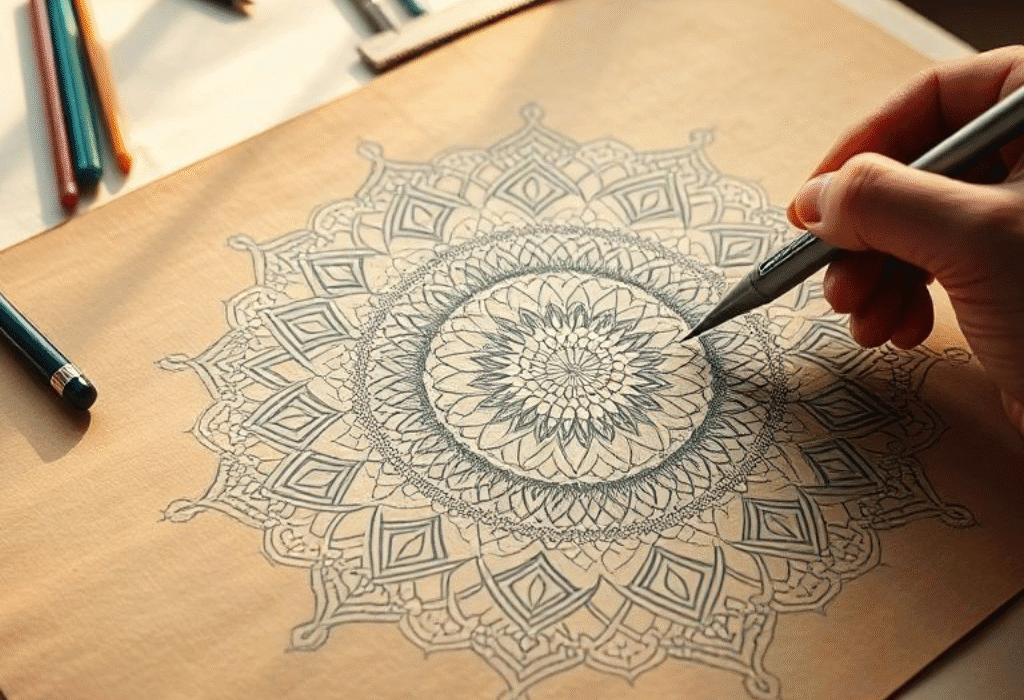
How to Draw Mandala Art
Introduction
More than just lovely designs, mandala art is a calming and contemplative drawing technique. Mandalas are geometric patterns with spiritual and symbolic meanings that are derived from the Sanskrit word for “circle.” Making mandalas is a fantastic way to start, regardless of your goals—whether they are to relax, increase creativity, or just learn something new.
We’ll walk you through every step of drawing mandala art in this tutorial, from laying out your base to adding fine details.
What is Mandala Art?
The Sanskrit word “mandala” means “circle.” Mandalas are a symbol of harmony, unity, and balance in many cultures. Mandalas are frequently seen in religious ceremonies, spiritual artwork, and contemporary creative settings.
Every mandala begins with a circle before expanding outward with recurring shapes and patterns. Because of this structure, mandalas are both aesthetically pleasing and, with a little perseverance, simple to make.
Benefits of Drawing Mandala Art
Drawing mandalas isn’t just about making something pretty—it also offers emotional and mental benefits:
Relieves stress
Improves focus and mindfulness
Encourages creativity
Helps with hand-eye coordination
Many people use mandala drawing as a form of art therapy, making it a calming hobby for any age.
Tools You Need to Draw Mandalas
To get started, you don’t need expensive equipment.
To get started, a few simple supplies are sufficient:
- Basic Materials: Eraser and pencil for drawing your base
- To draw even circles, use a ruler or compass.
- The protractor aids in the even division of the circle.
- To outline your patterns, use a fine liner or black pen.
Step-by-Step: How to Draw Mandala Art
Let’s break down the process into simple steps. Once you practice this a few times, you’ll develop your style.
Step 1: Draw the Base Circles
Start by drawing a large circle with a compass or by tracing a round object like a plate. Inside it, draw multiple smaller concentric circles. These will act as guides for your design.
Step 2: Divide the Circle
Use a ruler and protractor to divide your circle into equal sections, like slicing a pizza. 6, 8, or 12 sections are common, depending on the level of detail you want.
Step 3: Start from the Center
Begin your design from the centre of the circle and move outward. You can use shapes like petals, triangles, dots, or curved lines. Repeat these shapes around each ring for symmetry.
Step 4: Continue Layering Patterns
Each ring or layer can have its own unique design. Repeat elements in each section to keep it balanced. You can alternate shapes for variety—mix petals with swirls or geometric shapes.
Step 5: Ink Your Drawing
Once you’re happy with your design in pencil, trace over it using a black pen or fine liner. Go slowly to avoid mistakes.
Step 6: Erase Guidelines
After the ink is dry, gently erase the pencil marks and construction lines. This will make your final piece clean and polished.
Step 7: Add Colors (Optional)
If you love vibrant art, fill your mandala with colours using markers, coloured pencils, or watercolour paints. Use complementary shades for visual harmony.
Tips for Drawing Better Mandalas
The following useful advice will help your mandala artwork stand out:
- Start Easy: Don’t make your first mandala too complicated. Concentrate on a few distinct shapes and lines.
- Use References: Draw inspiration from traditional Tibetan or Indian mandalas.
- Be patient: the process is what makes mandala art what it is. Don’t hurry.
- Try Freehand Designs: After a few attempts, try drawing without a ruler or compass to see how well you can do it.
Different Styles of Mandalas
Mandala art can take many forms depending on your mood or purpose.
Here are a few popular styles to explore:
1. Geometric Mandala
Built using basic shapes—circles, triangles, and squares. Very balanced and clean.
2. Floral Mandala
Inspired by flowers and nature. Perfect for adding colour.
3. Spiritual Mandala
Often includes symbols like the lotus, the OM symbol, or elements from Buddhist and Hindu traditions.
4. Animal Mandala
Combining animals with mandala patterns, great for advanced practice.
Common Mistakes to Avoid
- Uneven Sections: Divide the circle appropriately by taking your time.
- Avoid adding too many patterns at once to avoid overcrowding. Simplicity has great power.
- Rushing the Inking: Take your time letting your hand follow the design on your pencil.
- Improper Centering: Verify your starting point at all times.
How Mandala Art Connects to Mindfulness
Mandala drawing is frequently likened to meditation. Your mind can unwind thanks to the steady hand movements and repetitive shapes. When drawing mandalas, many artists claim that time stops. For this reason, therapeutic workshops and mindful art practices employ mandala art.
Final Thoughts
It’s worthwhile to learn how to draw mandala art. Anyone can learn to draw mandalas, which is a rewarding skill that can be used for decoration, creativity, or relaxation.
Enjoy the process, start small, and be consistent. You will not only produce stunning artwork with each mandala, but you will also find a little more tranquilly in the process.
